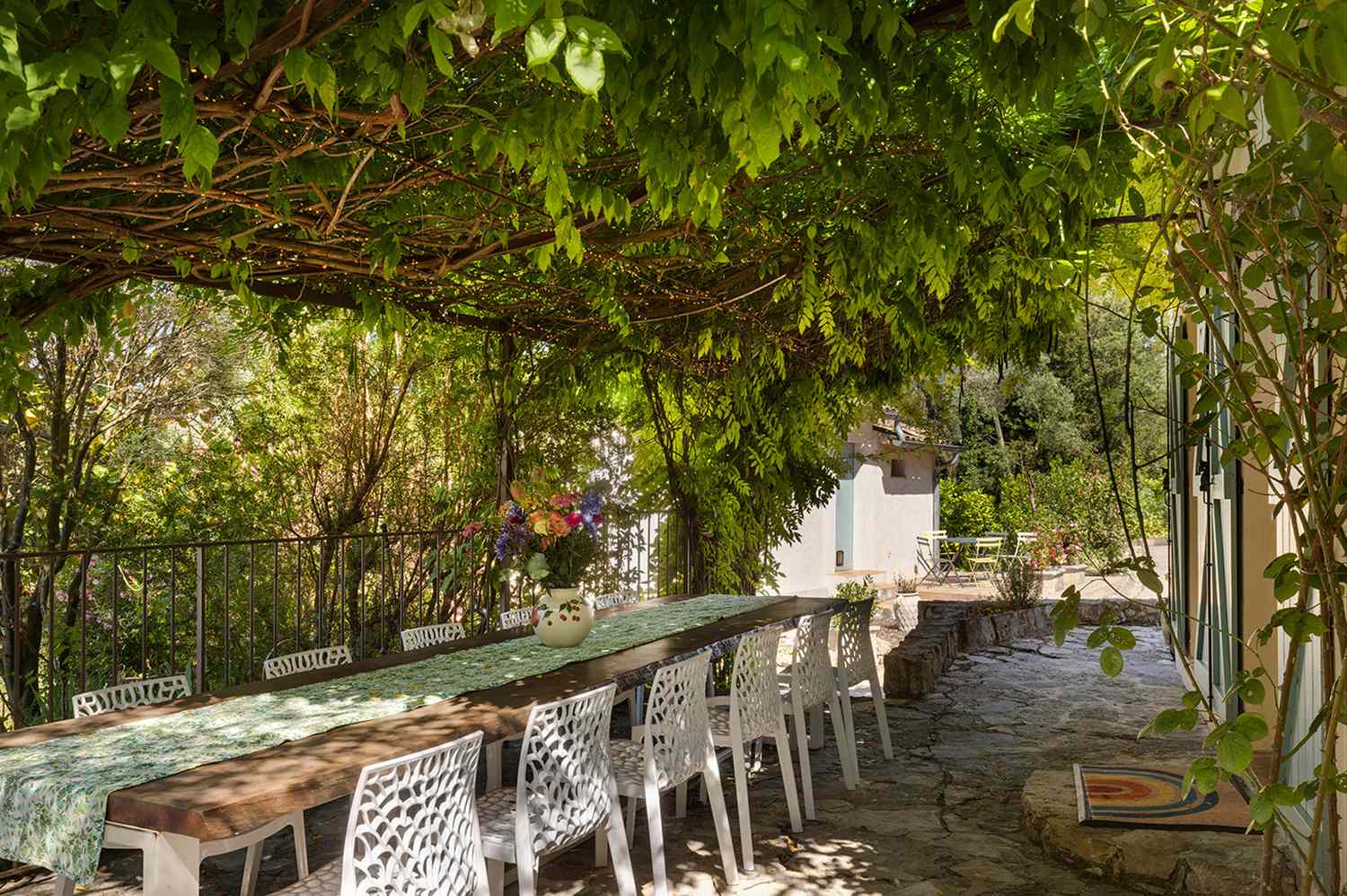:max_bytes(150000):strip_icc():format(jpeg)/TAL-header-exterior-table-la-peetch-JULIACHIAHOUSE0725-415fd2a6d7ca4bdf895d6a168bc4fa15.jpg)
Wild dill, it turned out, looked like a tiny bristle, like a hairbrush for a mouse. Squatting in the grass, I plucked a green sprig with my thumb and forefinger. I chewed one end—that was bright, citrusy dill, alright. On my tray it went among its fellow herbs. I didn’t usually sample random plants found underfoot, and up until this breezy May afternoon, I didn’t know how dill looked in its natural habitat. But edible herbs grew all over this particular garden. On my way back to the cottage, foraging tray full, I also waded past rosemary, basil, oregano, mint, marjoram, thyme, and chives swaying their purple-flowered heads.
The cottage was Julia Child’s former home in Plascassier, a village in Provence, Francewhere she lived on and off from 1965 to 1992. It’s named La Pitchoune (“the little one”), though she and her husband, Paul, affectionately called it La Peetch. I was staying there as a student at the Courageous Cooking School, a weeklong culinary course that’s taken up residence.
Peter Jackson/La Peetch
It felt like stepping into a scrapbook of Julia’s life: We cooked in her kitchen, where she developed recipes for “Mastering the Art of French Cooking: Volume 2.” We unhooked pots and pans from her original pegboard wall. Her pine-green Dutch oven, its enamel worn from perhaps decades of coq au vin, sat heavy in the cabinet. So did her old set of soufflé pans with little heart-shaped handles. The walls were papered with evidence of a well-lived life: a packing list (“writing eqpt. & reading, bottle opener”); black-and-white photos of long, liquid lunches with friends; and typeset directions to the house addressed to the chef James Beard, who stayed there.
This was where Julia and Paul Child cooked, drank, and hosted hungry friends. Now, it’s where six of us stood, fresh from ransacking the garden and clutching our knives like nervous acolytes, about to be initiated into the Courageous Cooking School’s particular brand of culinary heresy: that recipes were suggestions rather than scripture, and that cooking should be an adventure.
Karen Yuan/Travel + Leisure
The course operated on simplicity: no printed recipes, just a handful of students and a couple of instructors guiding us through the ingredients that made a dish work—salt, fat, acid, and aromatics. Our teachers were Kendall Lane, a sunny, Florida-born chef who previously worked in Michelin-starred kitchens, and Santana Caress Benitez, a Chopped champion with set up tattooed on her shoulder. The course’s steward was Makenna Held, an American chef who’d bought the cottage in 2016 site unseen, inspired by French cooking much like her predecessor.
They celebrated permission rather than precision: to taste as we went, to trust our senses. After all, Julia herself once famously dropped a potato pancake on the kitchen counter before scooping it back into a pan. (“You’re alone in the kitchen—who’s going to see?” She said in The French Chef episode.) Perfection was beside the point. The real lesson was learning to cook like someone who knew that dinner, like life, would go on even if the soufflé fell.
I sorely needed that lesson. Though I was a big fan of eatingthe irony was that I had a lot of anxiety around cooking, thanks to perfectionism and a respectful fear of sharp, pointy things. I ham-fisted recipes as if they were legal documents. The Courageous Cooking School felt like an intervention. Could a week at La Peetch help me loosen up and enjoy putting together a dish? My fellow students were regular folks from Vancouver, Chicago, and New Jersey; they worked in accounting, marketing, and health care. We were all drawn here by La Peetch’s mystique and our love for a good home-cooked meal. Julia might have been gone, but she always did love a brave cook. As I tied on my orange apron, I half-expected to hear that distinctive warble from the next room. But the only sound was the snick of my knife against wood, beginning the day’s first chop.
We’d driven to nearby Cannes earlier in the day, where we’d been dropped at the entrance of the Marché Forville, given an allowance, and set loose to buy any produce—any!—that we felt like. The market assaulted the senses: Stalls bore ripe strawberries that threatened to dissolve into syrup at a touch; their perfume cut through the briny tang of just-landed sea bass; a fromager presented a wheel of Banon cheese wrapped in chestnut leaves. Emboldened, I splurged on donut peaches, melons, and stalks of white and purple asparagus that could double as medieval weapons. I’d never cooked with any of them before, but that felt like the reason to try them. My classmates came back with just-as-tentative expressions and baskets full of red currants, squash blossoms, and heads of frisée.
Now, back in Julia’s kitchen, I was clumsily cutting that giant frisée into chunks. The mission: Mix fruits and veggies from the morning’s haul and make a no-rules raw salad—and have fun. Play with sources of fat and acid. Pile on any herbs and spices that pique your interest. “So much good stuff can be put in there,” Lane said. So my classmates and I massaged black lime and wild mesquite into the bitter frisée. We paired textures like mad scientists, tossing in crunchy fennel, leek, and red onion, which were sharpened by apple cider vinegar and sweet paprika, which melted into silky strawberries, red currants, and donut peaches, which, in turn, lit up through silk chili, pink peppercorn, hazelnut bits, and a reckless shower of lemon zest.
It was the wildest bowl of salad I’d ever made. Miraculously, it tasted sweet, tart, salty, and spiced all at once. We sampled as we went, adjusting acid, fat, and salt until the balance felt right. Each ingredient had a role. No dressing necessary—the layers were noisy with flavor. On our first day, Benitez had instructed us to bury our noses in the pantry’s jars of single-origin spices and get curious about them. This included Urfa pepper with its raisin-like depth, verjus cinnamon, and licorice-like grains of paradise. I wasn’t familiar with any of them and wouldn’t easily find them back at home, and so recognized this for what it was: a rare chance to travel around the world through the flavors and try something new.
So my classmates and I poured hearty amounts into our frisée. It was an exercise in cooking with abandon. “There’s always something fun or new to take away from an attempt, even if you don’t meet your initial goal,” Lane told us. Through the rest of the week, I often found myself reaching for the zappy, smoky black lime we’d macerated the frisée in. I didn’t know if I’d get access to the ingredient back home, but I resolved to bring more of those moments back into my cooking routine: adding something I usually never touched (maybe from the back of the fridge), biting down for a taste in progress, and raising my brows in shocked delight.
We cooked in that sunny kitchen through the week, scoring duck breast, caramelizing onions, filleting fish, prepping artichokes, and whipping up mousse. Along the way, we tried to decode what made food sing, flipping ingredients and expectations. The course ranged across starters, entrées, and desserts, demystifying a slew of classic French dishes. When Lane showed us how to make soufflés, her first lesson was that their puffy domes always fall. It was just gravity. “Release perfection from the start,” she encouraged. Later, she produced two towering soufflés out of the oven, perfectly quivering in Julia’s heart-handled pans. Then they slumped, just as promised. We devoured them anyway.
Karen Yuan/Travel + Leisure
In the evenings, we ate the fruits of our labor and lazed around the cottage. La Pitchoune is tucked off a sloping road, and each dusk did its best impression of a Provençal postcard. We’d list about the garden, where an enormous, centuries-old olive tree anchored beds of herbs, the rosemary planted by Julia’s own hands. We’d visit the chicken coop, where Blanche, the white hen, deposited our daily eggs. Or check out the old water cistern, half-hidden in the golden light, where Julia and her cookbook co-author, Simone Beck, had dunked themselves, laughing, to escape the summer heat. We’d lie by the actual pool (a modern fixture). If we were lucky, Lulu, the house cat, sleek as a ’60s starlet, would slip out to sit with us. We’d sip wine on the front patio under wisteria that cast lacy shadows over us.
At dinner at the end of the week, Megan, a fellow student from Chicago, confessed she’d arrived burnt out on cooking. “This week reminded me that I love it,” she said, scooping up the remains of a chocolate mousse we’d topped with berries and chilis.
We had left the kitchen for the last time, but the lights were still on. Somewhere, Julia was probably tutting at the mousse we’d just murdered. But she’d also taught people to cook without apology. I thought of that wild frisée salad with its layers of sultry mesquite, puckery vinegar, and peppercorns, garnished with dill I’d picked myself. It had been weird, generous, and alive. There were no tidy endings here, no certificates of mastery—just the understanding that cooking was exploring, even and especially if it took you where you didn’t mean to go. Some lessons, I guess, were meant to be tasted.





